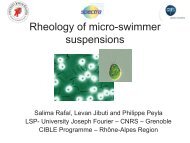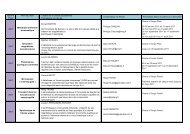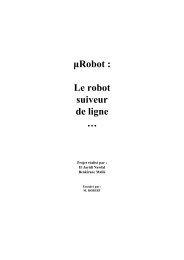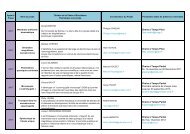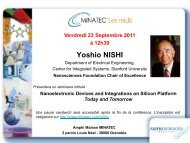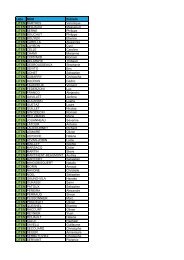2012 Thesis Prize Award Ceremony - Fondation Nanosciences
2012 Thesis Prize Award Ceremony - Fondation Nanosciences
2012 Thesis Prize Award Ceremony - Fondation Nanosciences
You also want an ePaper? Increase the reach of your titles
YUMPU automatically turns print PDFs into web optimized ePapers that Google loves.
<strong>2012</strong> <strong>Thesis</strong> <strong>Prize</strong><br />
<strong>Award</strong> <strong>Ceremony</strong><br />
Invitation<br />
Lecture Room - 2 nd floor<br />
CNRS - Building A<br />
25, rue des martyrs<br />
38000 Grenoble<br />
December 5, <strong>2012</strong><br />
4.30 pm - 7.30 pm
What is the <strong>Nanosciences</strong><br />
Foundation <strong>Thesis</strong> <strong>Prize</strong>?<br />
The <strong>Thesis</strong> <strong>Prize</strong> of the <strong>Nanosciences</strong> Foundation<br />
was created in 2009. The <strong>Prize</strong> is worth 1500€<br />
and is awarded every year to acknowledge the<br />
best PhD thesis realised in the <strong>Nanosciences</strong> field,<br />
prepared within one of the Grenoble laboratories.<br />
For this 4 th edition, 24 young PhD students had<br />
been nominated by their supervisors to enter the<br />
contest. This year again, two laureates of the<br />
University of Grenoble receive the <strong>2012</strong> <strong>Thesis</strong><br />
<strong>Prize</strong>: Anne-Cécile REYMANN (CEA - iRTSV/PCV)<br />
and Ioan Mihai POP (CNRS/UJF - Institut Néel).<br />
Our previous laureates:<br />
Jessica BAUR<br />
(UJF/ CNRS - DCM)<br />
Laureate of the ‘2011 <strong>Thesis</strong> <strong>Prize</strong>’<br />
Matthieu PIERRE<br />
(CEA/CNRS/UJF/G INP - INAC/SPSMS)<br />
Laureate of the ‘2011 <strong>Thesis</strong> <strong>Prize</strong>’<br />
Nicolas ROCH<br />
(CNRS/UJF - Institut NEEL)<br />
Laureate of the ‘2010 <strong>Thesis</strong> <strong>Prize</strong>’<br />
Dimitri HOUSSAMEDINE<br />
(CEA/CNRS/UJF/G INP - INAC/SPINTEC)<br />
Laureate of the ‘2010 <strong>Thesis</strong> <strong>Prize</strong>’<br />
What is an<br />
ERC Starting Grant?<br />
‘ERC’, the European Research Council,<br />
encourages high quality research in Europe<br />
through competitive funding.<br />
ERC Starting Grants are given to up-andcoming<br />
research leaders who are about to<br />
establish or consolidate their own research<br />
team and conduct independent research in<br />
Europe.<br />
Candidates are selected by international<br />
peer reviewers who rank proposals on the<br />
basis of scientific excellence as the sole<br />
criterion.<br />
The ERC scheme targets the best of the<br />
promising researchers who have the proven<br />
potential of becoming independent research<br />
leaders.<br />
Since its inception 5 years ago, the ERC has<br />
already granted 19 excellent researchers<br />
based in Grenoble, whose activities are<br />
closely linked to the Foundation’s fields of<br />
excellence.<br />
François VARCHON<br />
(CNRS/UJF - Institut NEEL)<br />
Laureate of the ‘2009 <strong>Thesis</strong> <strong>Prize</strong>’<br />
www.fondation-nanosciences.fr
<strong>2012</strong> <strong>Thesis</strong> <strong>Prize</strong> <strong>Award</strong> <strong>Ceremony</strong> Program<br />
December 5, <strong>2012</strong><br />
4.30 pm: Welcome talk by the Foundation’s President :<br />
Farid OUABDESSELAM<br />
PROGRAMME<br />
4.35 pm: Stéphane REDON (INRIA)<br />
Adaptive algorithms for computational nanoscience<br />
4.55 pm: David COOPER (CEA-LÉTI)<br />
Single active dopant detection in semiconductor nanowires using electron<br />
holography<br />
5.15 pm: Olivier ARCIZET (CNRS/UJF - Institut Néel)<br />
Hybrid quantum Nano-optomechanics<br />
5:40 pm: Anne-Cécile REYMANN (CEA - iRTSV/PCV)<br />
Dynamics of controlled actin network’s architecture<br />
6:00 pm: Ioan Mihai POP (CNRS/UJF - Institut NEEL)<br />
Coherent quantum phase-slips in a Josephson junction chain<br />
6.20pm: The <strong>Fondation</strong> awards the two laureates<br />
6.30pm: Cocktail at Maison des Magistères ‘Jean Perrin’<br />
To attend the <strong>2012</strong> <strong>Thesis</strong> <strong>Prize</strong> <strong>Award</strong> <strong>Ceremony</strong>, register for free on:<br />
http://ceremonie<strong>2012</strong>.eventbrite.com
Dynamics of controlled actin network’s<br />
architecture<br />
Anne-Cécile REYMANN<br />
PhD of University of Grenoble<br />
iRTSV/PCV<br />
Laureate of the<br />
‘<strong>2012</strong> <strong>Thesis</strong> <strong>Prize</strong>’<br />
Actin networks are one of those fabulous self-organized<br />
biopolymers that sustain cell architecture while those<br />
perform highly complex mechanical transformations in<br />
order to achieve efficient morphogenesis, cell motility<br />
or any cell shape changes. Perpetual dynamics,<br />
organization, regulation or rapid reconstruction are only<br />
a few of the properties required for these morphological<br />
features which are supported by the actin cytoskeleton.<br />
During my thesis, I have developed different projects in<br />
order to tackle the problem of actin network dynamics<br />
and organization as well as the molecular mechanism<br />
at the origin of force production in biomimetic<br />
reconstituted systems. Stepping aside from the<br />
conventional actin based particles’ motility studies,<br />
one of the major innovations was to generate highly<br />
ordered auto-assembled actin motifs, finely tuned by<br />
the reproducible spatial control of actin nucleation<br />
sites by micropatterning. Moreover the presence of<br />
molecular motors, such as myosin, on these controlled<br />
systems allowed us to reproduce some of the cellular<br />
biomechanical processes of tension and contractility.<br />
A direct visualization of filaments demonstrates<br />
a spectacular myosin-induced actin network<br />
deformation and disassembly that depend on the<br />
original network architecture.<br />
Following an “orientation selection” mechanism such<br />
phenomenon could therefore play an essential role in<br />
the spatial regulation and scalability of expanding and<br />
contracting regions of actin cytoskeleton in cells.<br />
Ioan Mihai POP<br />
PhD of University of Grenoble<br />
Institut Néel<br />
Laureate of the<br />
‘<strong>2012</strong> <strong>Thesis</strong> <strong>Prize</strong>’<br />
Coherent quantum phase-slips in a<br />
Josephson junction chain<br />
The central result of my thesis is the observation<br />
of quantum phase-slips in Josephson junction<br />
networks. A phase slip is associated with the<br />
passage of a magnetic quasi-particle (a “fluxon”)<br />
through a Josephson junction chain.<br />
We have observed the quantum interference of<br />
phase slips, an effect predicted by Y. Aharonov<br />
and A. Casher in 1984. This is the electromagnetic<br />
dual of the well-known Aharonov-Bohm effect.<br />
We have also demonstrated that a chain of<br />
Josephson junctions, which is a complex<br />
mesoscopic object, can accurately be treated<br />
as a single quantum object, with few degrees of<br />
freedom.<br />
These results open the way for a wide range<br />
of possible uses of quantum phase-slips in the<br />
design of novel Josephson junction circuits, such<br />
as topologically protected qubits, frequencyto-current<br />
conversion devices or quantum<br />
simulators.<br />
http://ceremonie<strong>2012</strong>.eventbrite.com<br />
www.fondation-nanosciences.fr
Stéphane REDON<br />
INRIA<br />
‘ERC Starting Grant <strong>2012</strong>’<br />
David COOPER<br />
CEA-LÉTI<br />
‘ERC Starting Grant <strong>2012</strong>’<br />
Adaptive algorithms for computational<br />
nanoscience<br />
In this talk, we will review the current efforts of<br />
the NANO-D group at INRIA on the development<br />
of a theory, and associated algorithms, for<br />
adaptive simulation of nanosystems.<br />
In particular, we will present SAMSON, the<br />
software platform being developed in the group<br />
(SAMSON: Software for Adaptive Modeling and<br />
Simulation Of Nanosystems).<br />
Stephane Redon leads the NANO-D research<br />
group at the INRIA Grenoble - Rhone-Alpes<br />
Research Center. He received a Ph.D.<br />
in Computer Science in 2002 from INRIA<br />
Rocquencourt - Evry University, France and<br />
spent two years in the Department of Computer<br />
Science of the University of North Carolina<br />
at Chapel Hill as a Post-Doctoral Research<br />
Associate, before becoming a permanent<br />
research at INRIA in March 2005. His research<br />
interests have included the design of robust and<br />
realistic real-time virtual environments, collision<br />
detection, haptics, motion planning, simulation<br />
levels of detail, and computational molecular<br />
biology. His current research is centered on<br />
the development of computational methods for<br />
modeling and simulation of natural and artificial<br />
nanosystems.<br />
Single active dopant detection in semiconductor<br />
nanowires using electron holography<br />
Off-axis electron holography is a transmission electron<br />
microscopy based technique that uses an electron<br />
biprism to interfere an electron wave that has passed<br />
through a region of interest with an electron wave that<br />
have passed through a vacuum reference. From the<br />
resulting interference pattern, known as a hologram<br />
the phase change of the electrons can be recovered.<br />
As the phase of an electron is sensitive to the magnetic<br />
and electrostatic fields, then this technique can be<br />
used to recover properties such as the potentials from<br />
active dopants, magnetic fields and strain fields with<br />
nm-scale resolution.<br />
As semiconductor devices become smaller, the<br />
distribution of the dopant atoms within them becomes<br />
more and more important and introduces variability in<br />
their electrical performance. This project will develop<br />
the spatial resolution and sensitivity of electron<br />
holography in order to detect single dopant atoms in<br />
semiconductor devices using a state-of-the-art FEI<br />
Titan TEM which is located at Minatec. The aim is to<br />
be able to operate these devices in situ in the TEM<br />
and link their electrical properties to the positions<br />
of these individual dopants.<br />
David Cooper received his PhD from the University<br />
of Cambridge in 2006 in the subject of electron<br />
holography. Since then David has been at CEA LETI,<br />
developing a range of TEM-based techniques for the<br />
characterisation of semiconductors.<br />
http://ceremonie<strong>2012</strong>.eventbrite.com<br />
www.fondation-nanosciences.fr
Olivier ARCIZET<br />
CNRS/UJF - Institut Néel<br />
Already 19 Grenoble-based researchers in the<br />
nanosciences field have received European grants<br />
‘ERC Starting Grant <strong>2012</strong>’<br />
Hybrid quantum Nano-optomechanics<br />
<strong>2012</strong><br />
Wiebke<br />
GUICHARD<br />
Institut Néel<br />
Olivier<br />
ARCIZET<br />
Institut Néel<br />
Jacek<br />
KASPRZAK<br />
Institut Néel<br />
Tristan<br />
MEUNIER<br />
Institut Néel<br />
The intense experimental efforts generated by several<br />
groups worldwide during the last 5 years have very<br />
recently culminated by demonstrating what the<br />
scientific community considered unconceivable only<br />
10 years ago: cooling a macroscopic mechanical<br />
oscillator down to its quantum ground state of motion.<br />
Various kinds of mechanical oscillators have now<br />
been prepared at ultralow mean phonon occupancy<br />
by combining traditional cryogenic and active cooling<br />
techniques, opening the road towards quantum<br />
nanomechanics. It is now time to envision even more<br />
challenging experiments aiming at engineering the<br />
quantum mechanical state of the oscillator. This can<br />
only be achieved by coupling the ultracold oscillator<br />
to a second system whose quantum state can be<br />
independently controlled and transferred onto the<br />
mechanical oscillator. The combination of these two<br />
components defines a “hybrid” mechanical system.<br />
This project aims at exploring the emerging field of<br />
hybrid quantum nano-optomechanics in a setting where<br />
both components of the system can be simultaneously<br />
monitored and controlled. Our goal is to investigate the<br />
hybrid coupling between a nanomechanical oscillator<br />
and a Nitrogen Vacancy defect in diamond.<br />
Olivier Arcizet received his PhD in 2007 from the<br />
Kastler Brossel Laboratory (Paris). After two years at<br />
Max Planck Institute for Quantum Optics in Garching<br />
as a post-doctoral scientist, he joined the Institut Néel<br />
in Grenoble where he’s pursuing his research on<br />
hybrid nano-optomechanics systems.<br />
http://ceremonie<strong>2012</strong>.eventbrite.com<br />
2011<br />
2010<br />
2009<br />
2008<br />
Stéphane<br />
REDON<br />
INRIA<br />
Eva<br />
MONROY<br />
INAC<br />
David<br />
COOPER<br />
LÉTI<br />
Max<br />
HOFHEINZ<br />
INAC<br />
Catherine<br />
PICART<br />
LMGP<br />
Bernard<br />
DIENY<br />
SPINTEC<br />
Vincent<br />
ARTERO<br />
iRTSV/LCBM<br />
Manuel<br />
THERY<br />
iRTSV/LPCV<br />
Silvano<br />
DE FRANCESCHI<br />
INAC<br />
Maxime<br />
RICHARD<br />
Institut Néel<br />
Thomas<br />
ERNST<br />
LÉTI<br />
Wolfgang<br />
WERNSDORFER<br />
Institut Néel<br />
Xavier<br />
WAINTAL<br />
INAC<br />
Marek<br />
POTEMSKI<br />
LNCMI<br />
Jean-Louis<br />
BARRAT<br />
LIPhy<br />
Starting GRANT<br />
Advanced GRANT
F O N D A T I O N N A N O S C I E N C E S<br />
23 rue des martyrs - 38000 Grenoble FRANCE<br />
Tel: 00 33 4 56 52 96 28 - www.fondation-nanosciences.fr



